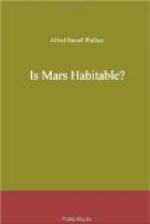The figure he uses in his calculations for the actual albedo of the earth, 0.75, is also not only improbable, but almost self-contradictory, because the albedo of cloud is 0.72, and that of the great cloud-covered planet, Jupiter, is given by Lowell as 0.75, while Zollner made it only 0.62. Again, Lowell gives Venus an albedo of 0.92, while Zollner made it only 0.50 and Mr. Gore 0.65. This shows the extreme uncertainty of these estimates, while the fact that both Venus and Jupiter are wholly cloud-covered, while we are only half-covered, renders it almost certain that our albedo is far less than Mr. Lowell makes it. It is evident that mathematical calculations founded upon such uncertain data cannot yield trustworthy results. But this is by no means the only case in which the data employed in this paper are of uncertain value. Everywhere we meet with figures of somewhat doubtful accuracy. Here we have somebody’s ‘estimate’ quoted, there another person’s ‘observation,’ and these are adopted without further remark and used in the various calculations leading to the result above quoted. It requires a practised mathematician, and one fully acquainted with the extensive literature of this subject, to examine these various data, and track them through the maze of formulae and figures so as to determine to what extent they affect the final result.
There is however one curious oversight which I must
refer to, as it is a point to which I have given much
attention. Not only does Mr. Lowell assume, as
in his book, that the ‘snows’ of Mars consist
of frozen water, and that therefore there is
water on its surface and water-vapour in its atmosphere,
not only does he ignore altogether Dr. Johnstone Stoney’s
calculations with regard to it, which I have already
referred to, but he uses terms that imply that water-vapour
is one of the heavier components of our atmosphere.
The passage is at p. 168 of the Philosophical Magazine.
After stating that, owing to the very small barometric
pressure in Mars, water would boil at 110 deg.
F., he adds: “The sublimation at lower
temperatures would be correspondingly increased.
Consequently the amount of water-vapour in the Martian
air must on that score be relatively greater than
our own.” Then follows this remarkable
passage: “Carbon-dioxide, because of its
greater specific gravity, would also be in relatively
greater amount so far as this cause is considered.
For the planet would part, caeteris paribus,
with its lighter gases the quickest. Whence as
regards both water-vapour and carbon-dioxide we have
reason to think them in relatively greater quantity
than in our own air at corresponding barometric pressure.”
I cannot understand this passage except as implying
that ’water-vapour and carbon-dioxide’
are among the heavier and not among the lighter gases
of the atmosphere—those which the planet
‘parts with quickest.’ But this is
just what water-vapour is, being a little less
than two-thirds the weight of air (0.6225), and one
of those which the planet would part with the
quickest, and which, according to Dr. Johnstone Stoney,
it loses altogether.
*
* * * *




